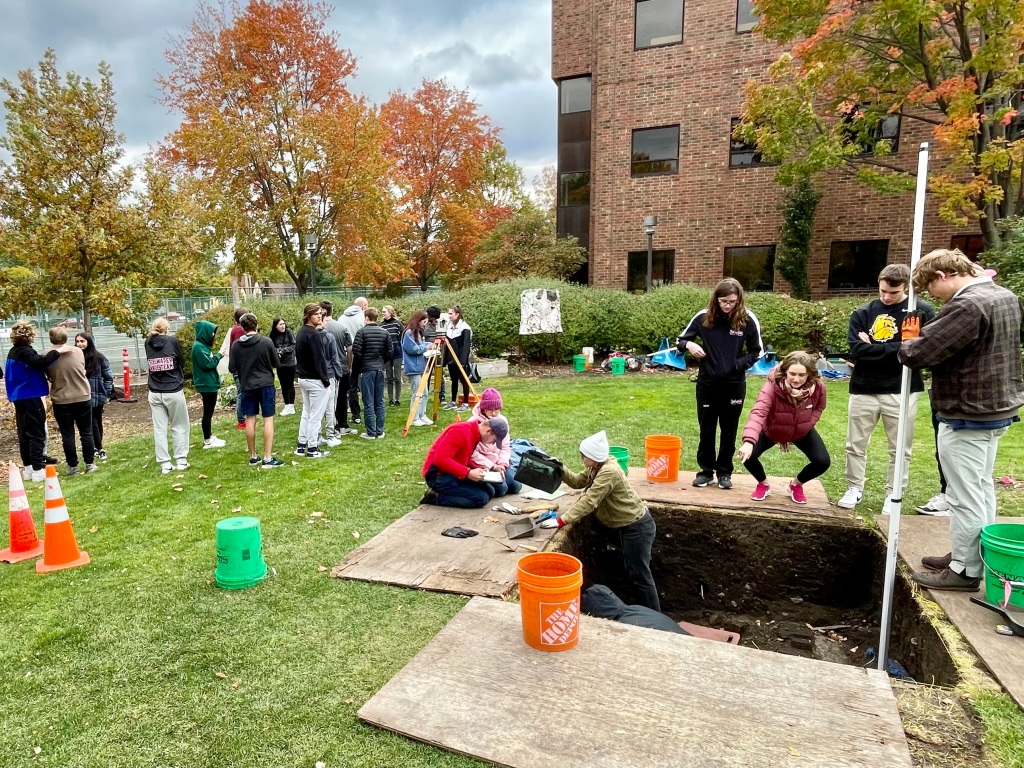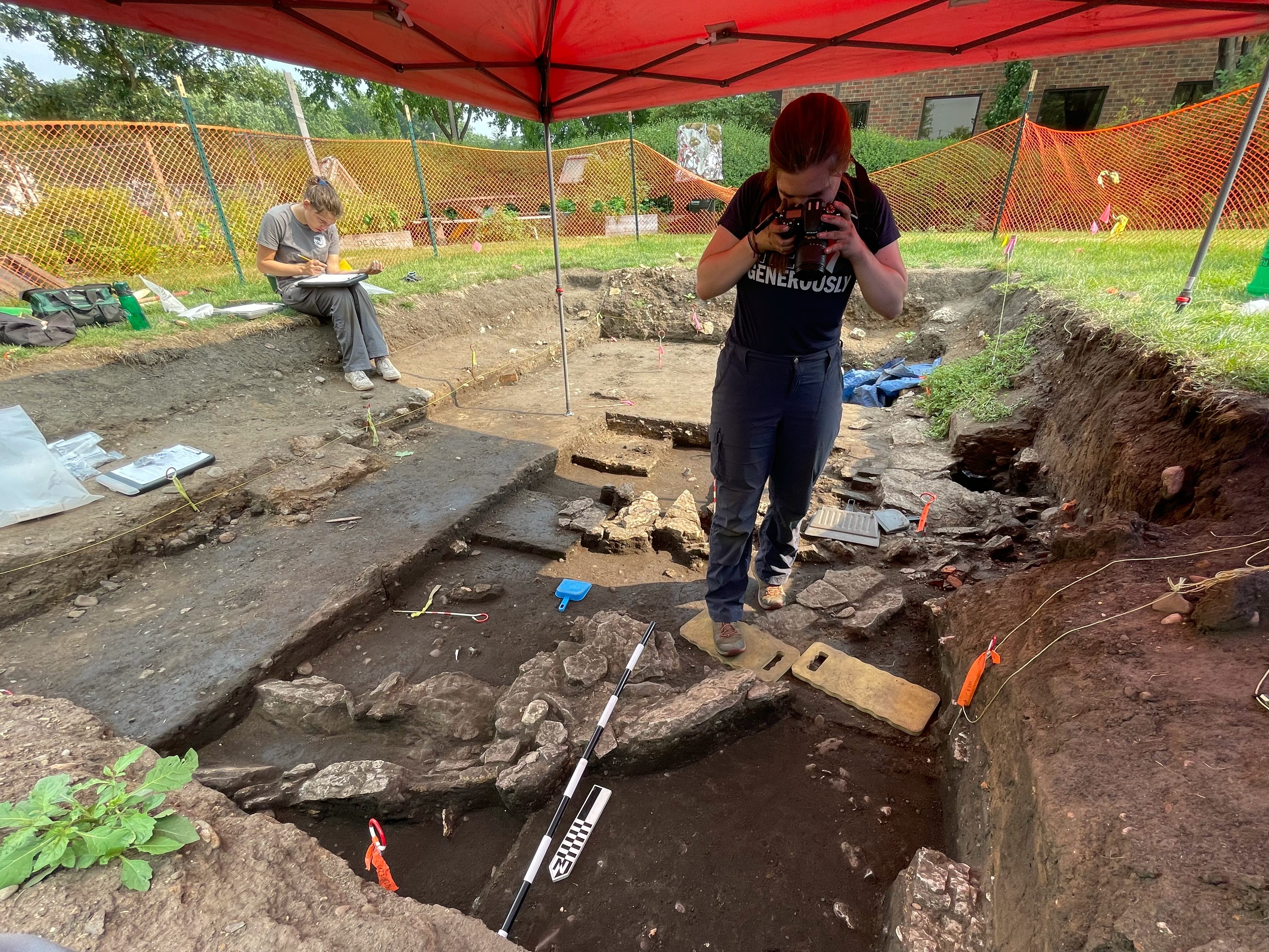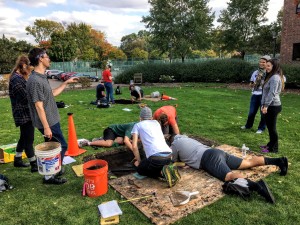
2011 Class Excavating at Old Main
This post is for Hamline students interested in registering for my fall class ANTH 3130: Excavating Hamline History.
This class offers a unique opportunity to participate on an archaeological excavation as part of an interdisciplinary and collaborative project. It’s an interdisciplinary class because of the students. I ask each of you to contribute to the overall project goals based on either your major studies or other areas of interest and expertise that you have.
Your contribution may be in a research area – where you apply your research skills to questions about the site, or the artifacts, or the historical background. The first time I taught this course we excavated Hamline University’s original Hall of Science, a three story brick building constructed in 1887. A chemistry major in the class analyzed the chemical composition of the building’s bricks, a history major collected oral history accounts from alumni and faculty, an economics major analyzed 125 year-old bills and receipts from the building’s construction, and an archaeology student analyzed the distribution of glass artifacts recovered in our excavations.
Other students contributed by presenting and interpreting our project in various media including designing a web site, filming a video, writing a play, printing posters, and putting together an exhibit. We also had an education major that brought over Hancock 6th graders so they could experience archaeology first hand. Our philosophy major examined the ethics of archaeology. And our environmental studies major looked at the intersection of environmental protection and cultural resource management laws.

Max and Mike excavating at Old Main.
One other area that students can contribute is by making the project more connected to the Hamline neighborhood and Hamline University communities. The Hamline History Project, at its heart, is a community archaeology project. One of the goals of our class is to provide opportunity for community involvement in our excavations. We work closely with the Hamline-Midway History Corp to define research questions and identify sites for excavation. We also have Saturday open digs so that anyone can participate in the excavations. I particularly like to see parents and their kids exploring first hand the archaeology of their community. Students have contributed to the public history component of our project

Meaghan (in red shirt) and her public art project (Fall 2011).
through their work in community and University organizations and in media relations. The last time I taught the class, an art student created a participatory art project – where people could help paint a picture of University Hall (the predecessor to Old Main) while we dug the site.
The point is, you can pursue just about any idea you want – from art to women’s studies. What you need is an ability to collaborate on other people’s projects, an enthusiasm for interdisciplinary research, and a willingness to connect with the community in the exploration of our neighborhood’s public history.

Our muddy trench at the 2009 Church site dig.
In addition to your own projects, you will be expected to participate in the fieldwork – which means you’ll be working outside on a sunny afternoon in September (which is a lot of fun), but you’ll also be working outside on a snowy day in November (which can be a little cold and muddy). Each student is also expected to help with our community outreach. You will need to be available for at least one Saturday during September and October.
I don’t yet know what sites we’ll be digging this fall. I’d like to continue our excavations of the Territorial Road. I’d also like to do some more ‘backyard’ sites. The vacant lot north of Hewitt on the east end of campus used to have several houses – so there’s a lot of backyard to dig just on campus. Other campus sites we might dig include a fire station located near the Drew Fine Arts building, Old Main, and (if we can find it), the farmstead that pre-dated the Hamline campus.
If this sounds interesting then write a brief comment to this post outlining what ways you could contribute to this fall’s class. Also tell me a little bit about yourself (including your major and year). Finally, I would like to know why you are interested in joining the class and what you hope to gain from your participation. You may want to look at posts tagged as “Hamline History” to get a better idea of what this class is all about. You can find these posts by clicking “Hamline History” under Categories on the right side of this blog. In particular, you may want to check out what students wrote when I offered the class in 2009 and 2011.
If you take this class be prepared for a challenge, some fun, and a non-traditional educational experience.
Registration note: I recommend that everyone sign-up for a back-up class if your turn to register comes up before I have decided which of you to accept into this class.
























Recent Comments